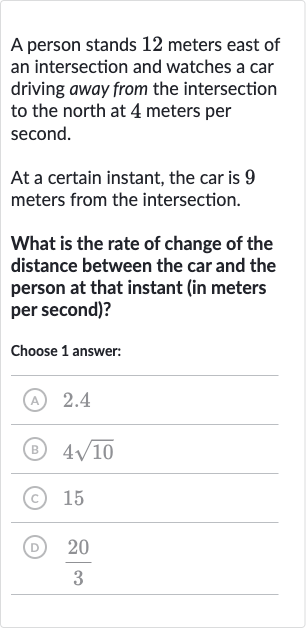AI tutor
Welcome to Bytelearn!
Let’s check out your problem:

A person stands meters east of an intersection and watches a car driving away from the intersection to the north at meters per second.At a certain instant, the car is meters from the intersection.What is the rate of change of the distance between the car and the person at that instant (in meters per second)?Choose answer:(A) .(B) (C) (D)
Full solution
Q. A person stands meters east of an intersection and watches a car driving away from the intersection to the north at meters per second.At a certain instant, the car is meters from the intersection.What is the rate of change of the distance between the car and the person at that instant (in meters per second)?Choose answer:(A) .(B) (C) (D)
- Calculate Distance: Let's call the distance between the car and the person "d". Initially, the car is meters from the intersection and the person is meters from the intersection. Using the Pythagorean theorem, we have:
- Rate of Change: Now, we need to find the rate of change of with respect to time, which is . Since the car is moving away from the intersection at meters per second, we can use related rates to find . The car's distance from the intersection is increasing, so we'll call this rate .
- Related Rates: Differentiating both sides of the Pythagorean equation with respect to time, we get:We know that the person is not moving, so their rate is , and is m/s.
- Solve for : Now we solve for :We already found that meters, so we substitute that in: meters per second.
